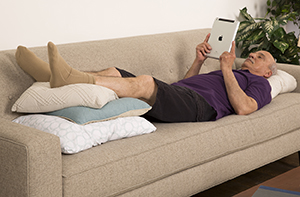Treating Gout Attacks
Gout is a painful form of arthritis that affects the joints. It's caused by excess uric acid in your blood. The uric acid can cause sharp crystals to form in your joints. If not treated, it can lead to painful foot and joint changes. It may cause kidney problems. But if you treat gout early, you can ease pain and help prevent problems. Gout can often be treated with medicine and changes in diet. In severe cases, surgery may be needed.
Gout attacks often happen more than once. Taking medicines may reduce pain. It can also help prevent attacks. There are things you can do at home to ease symptoms.
Medicines for gout
Your healthcare provider may prescribe a daily medicine to reduce levels of uric acid. Reducing your uric acid levels may help prevent gout attacks. Allopurinol is a common medicine for this. It is taken daily to reduce uric acid levels. Other daily medicines used to reduce uric acid levels include febuxostat and probenecid.
You may be prescribed medicines, such as NSAIDs (nonsteroidal anti-inflammatory drugs), steroids, or colchicine. These are not for daily use. They may be used to ease an acute gout attack.
Make sure to take all medicine as directed.
Easing symptoms
Below are some things you can do at home to ease gout symptoms. Your healthcare provider may have other tips.
-
Rest the painful joint as much as you can.
-
Raise the painful joint so it's at a level higher than your heart.
-
Put an ice pack on it for 10 minutes every 1 to 2 hours. To make an ice pack, put ice in a plastic bag that seals at the top. Wrap the bag in a thin towel or cloth. Don’t put ice or an ice pack directly on the skin.
 |
| Raising the joint above the level of your heart can help reduce gout symptoms. |
How can I prevent gout attacks?
You may be able to prevent gout attacks. Below are some things you can do.
Don't eat foods high in purines. This includes:
-
Some types of meat (red meat, processed meat, turkey)
-
Organ meats (kidney, liver, sweetbread)
-
Shellfish (lobster, crab, shrimp, scallop, mussel)
-
Some types of fish (anchovy, sardine, herring, mackerel, trout, haddock, tuna)
Also aim to:
-
Not have food or drinks with high fructose corn syrup.
-
Reduce or cut out alcohol. This is most important with beer, but also red wine and spirits.
-
Drink plenty of water. This is to help flush uric acid from your body
-
Eat complex carbohydrates (such as beans, brown rice, nuts, oatmeal, and starchy vegetables).
-
Use low-fat dairy products for protein instead of meat and seafood.
And make sure to:
-
Take any medicines prescribed by your healthcare provider.
-
Lose weight if your provider advises.
-
Exercise. Ask your provider what types of activities are good for you and how often to do them.
-
Control your blood pressure, diabetes, and cholesterol.
-
Pay attention to your feelings. The long-standing jokes and stigma about gout, as well as the pain and the needed lifestyle changes, can lead to depression. Talk to your family, friends, or provider if you're feeling down. And get additional help if needed.
Online Medical Reviewer:
Dan Brennan MD
Online Medical Reviewer:
Marianne Fraser MSN RN
Online Medical Reviewer:
Rita Sather RN
Date Last Reviewed:
3/1/2024
© 2000-2024 The StayWell Company, LLC. All rights reserved. This information is not intended as a substitute for professional medical care. Always follow your healthcare professional's instructions.